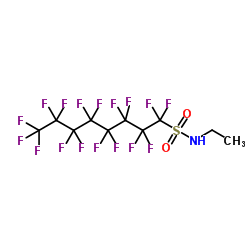Biotransformation of N-ethyl perfluorooctanesulfonamide by rainbow trout (Onchorhynchus mykiss) liver microsomes.
Gregg T Tomy, Sheryl A Tittlemier, Vince P Palace, Wes R Budakowski, Eric Braekevelt, Lyndon Brinkworth, Ken Friesen
文献索引:Environ. Sci. Technol. 38(3) , 758-62, (2004)
全文:HTML全文
摘要
Rainbow trout (Onchorhynchus mykiss) liver microsomes were incubated with N-ethyl perfluorooctanesulfonamide [N-EtPFOSA, C8F17SO2NH(C2H5)], to examine the possibility of in vitro biotransformation to perfluorooctane sulfonate (PFOS, C8F17SO3-) and perfluorooctanoate (PFOA, C7F15COO-). Incubations were performed by exposing trout liver microsomes to N-EtPFOSA at 8 degrees C in the dark. Reaction mixtures were analyzed after incubation periods of 0, 2, 4, 8, 16, and 30 h for N-EtPFOSA, PFOS, PFOA, and perfluorooctanesulfonamide (PFOSA, C8F17SO2NH2), a suspected intermediate. Amounts of PFOS and PFOSA were found to increase with incubation time, but only background levels of PFOA were detected. Three possible reaction pathways are proposed for the conversion of N-EtPFOSA to PFOS: (i) direct conversion of N-EtPFOSA to PFOS by deethylamination accompanied by conversion of the sulfone group to sulfonate, (ii) deethylation of N-EtPFOSA to PFOSA, followed by deamination to form PFOS, and (iii) direct hydrolysis of N-EtPFOSA. These findings represent the first report indicating a possible biotransformation of a perfluorosulfonamide to PFOS in fish and may help to explain the detection of PFOS, which is relatively involatile, and thus not likely to undergo atmospheric transport, in biota from remote regions.
相关化合物
| 结构式 | 名称/CAS号 | 分子式 | 全部文献 |
|---|---|---|---|
 |
氟虫胺
CAS:4151-50-2 |
C10H6F17NO2S |
|
Field evaluation of potential control strategies against the...
2007-08-01 [J. Econ. Entomol. 100(4) , 1391-9, (2007)] |
|
Sulfluramid resistance and vapor toxicity in field-collected...
1992-03-01 [J. Med. Entomol. 29(2) , 207-15, (1992)] |
|
Comparative hepatic in vitro depletion and metabolite format...
2014-10-01 [Chemosphere 112 , 225-31, (2014)] |
|
Biodegradation of N-ethyl perfluorooctane sulfonamido ethano...
2013-02-05 [Environ. Sci. Technol. 47(3) , 1381-9, (2013)] |
|
Toxicity, sublethal effects, and performance of sulfluramid ...
1990-08-01 [J. Econ. Entomol. 83(4) , 1409-14, (1990)] |